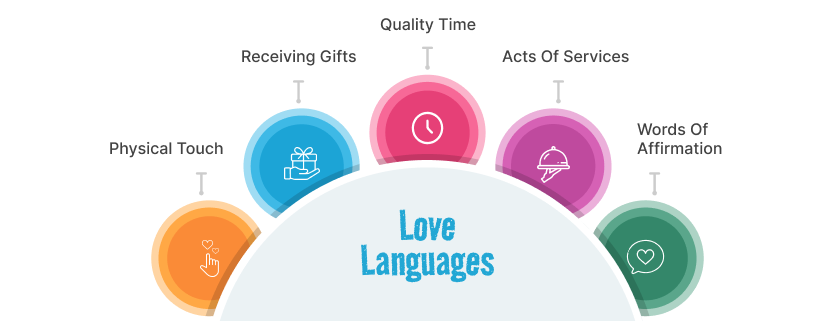Everyone has a primary love language. A love language is how a person expresses love to, and receives it from, their loved ones. Normally when we speak about love languages, our mind automatically thinks about romantic relationships. However, this term can also apply to various other relationships, such as friendships or work collaborations.
But let’s just stick to romantic relationships in this blog. When it comes to expressing love in a relationship, it can vary greatly from person to person like how they give and receive it. For this reason, it’s vital to understand what your love language or languages are. Similarly, you must also get an idea of the love language(s) of your partner.
So not only will you express better how you want to receive love but will also be able to learn and be fluent in the love language of your partner. This will help you foster a meaningful, happy, and fulfilling relationship with your spouse or partner, as per Dr. Gary Chapman’s insights who first gave the concept of love languages. Dr. Chapman is an author and counselor who introduced this concept in his famous book “The 5 Love Languages“.
Table of Content
What are the 5 Love Languages?
Dr. Chapman mentions the following 5 love languages in his bestselling book:
- Quality time
- Words of affirmation
- Physical touch
- Acts of service
- Gifts
The author describes that every person prefers a specific language more than any other. This is their primary love language. But this doesn’t make the other 4 love languages irrelevant to a person. As Chapman states in his theory, people can also have a secondary love language.
However, meeting the primary love language of the partner is a must. If you don’t meet it, they will feel dissatisfied. For instance, if the primary language of your partner is physical touch. But if you don’t show them physical affection, all other languages won’t make up for the lack of their primary language. Keeping this in mind, if you desire a successful relationship, you must understand and focus on a language your partner prefers.
What are the Different Love Languages?
Let’s delve deeper into each of the five love languages. Here we will describe each love language along with their examples.
1. Quality time
As the name suggests, those having quality time as their love language must be in frequent contact with their partner. But it won’t cut it if both of you simply sit on the couch and scroll up or down your mobile phones. Rather you need to spend high-quality time with each other. What do we mean by high-quality time? Well, you people can engage in conversation or active listening. And give each other unattended attention while you’re together. Since most people follow hectic schedules, taking the time out of your busy life is a powerful way to show how much value you give to them.
Consider if quality time is the love language of your partner but you don’t rank it highly. In this case, you will be unable to understand why this is so important. For instance, you might compliment your better half every day and feel confused and bewildered why they are not so happy. Therefore, it’s always good to ask them how they would like to receive love from you. You can brainstorm a long list of thighs they would like to do with you if quality time is their primary love language.
Examples:
This is how you can express your love using “quality time” as a love language.
- Dance to your most cherished songs.
- Work out together.
- Play board games.
- Try a new hobby.
- Cuddle together in bed daily.
- Go for a morning walk.
- Set up a regulator movie or date night.
- Cook together in the kitchen.
- Have quality conversations.
- Don’t look at phones while you’re together.
- Plan a vacation or holiday together.
- Learn painting or any other together.
2. Words of Affirmation
People with words of affirmation as their love language feel cared for and valued when their partner verbalizes their feelings. They want to hear what their partner appreciates the most about them. So, “words of affirmation” is one of the 5 love languages that express affection and appreciation for someone through words. These words could be spoken, written, or anything in between.
Thus, being authentic and expressing your feelings becomes essential in words of affirmation. If you feel you’ll be unable to express yourself out loud, it’s time to send a text or write a note to them. The key is to acknowledge and appreciate them through your words.
Find out whether your loved one likes to hear their value in a clearly expressed manner. If this is the case, they will feel like you don’t appreciate them highly enough without positive words of affirmation.
And if you’re confident that “words of affirmation” is the primary love language of your partner, your best bet is to learn how you can speak to them using this language. It would be an amazing exercise if you can just write down 10-15 things that make your partner so special. These things could be anything like their innate traits, things they do especially for you, and more. Any simple sentence like “I just love it when you do ______ – how nice and thoughtful it is” will land perfectly with such a person.
Examples:
Some examples of words of affirmation are as follows:
- I’m proud of you.
- You’re close to my heart.
- I need you.
- I’m always here for you.
- Thanks for loving me.
- My life is incomplete without you.
- I apologize for…
- You’re my best friend.
- You’re God’s biggest gift to me.
3. Physical Touch
Of all other love languages, this is perhaps the most simplest and self-explanatory language. If this is the love language of your partner, they would put the utmost value on being in regular physical contact with you. However, physical touch does not always mean anything sexual. Rather, you can manifest it in a lot of other ways.
For instance, you can sit close to your partner most of the time while holding each other’s hands. Similarly, you can also express love in this language by hugging your mate or snuggling. The more intimate forms of physical touch could be kissing and other sexual activities. All persons who express love in this way agree that physical contact with their partner makes them feel loved, protected, and secure.
If you’re someone who does not give too much value to physical touch, still you need to remind yourself that your significant other does need this. That’s why you can set a goal that you will give them a certain number of kisses or hugs every day. You can also develop a ritual in which you would kiss them on their forehead every time you reach back home.
But if you don’t want to get that physically close, you can come up with alternatives. For instance, when you’re in bed, chances are you don’t feel comfortable if someone just wraps around you. In such a circumstance, holding hands can help. Or you can rest your feet against the feet of your partner to give them physical comfort.
Examples:
- Give your partner a body massage.
- Give them hello and goodbye hugs.
- Hold their hand while walking.
- Comb through your partner’s hair.
- Stroke their cheeks gently.
- Kiss them on the forehead.
- Prioritize sex with your partner.
- Sit close to your lover on the couch.
4. Acts of Service
This is one of 5 love languages that’s more about “doing” instead of just “saying”. If this is your love language, you will feel that your soul mate loves you so much when they run an errand for you. Or when they help you to fix broken things, plan and organize events, and more. In other words, your partner takes away or reduces stress or burden from your life and you feel the most valued. This might involve taking on more parenting duties than is reasonable, doing a chore you’ve been putting off, or making sure everything in the home functions properly.
People with this language often believe that it’s easy for anyone to just utter flattering or complimentary remarks. But showing your willingness to do hard work and lessen your partner’s workload is what proves the foundation of love.
Being a person, it’s possible that you may not rate acts of service as highly. However, you must think that your partner wants to receive love in this way. As a result, you will have to notice very carefully the things that make your partner unhappy on a daily basis. Ask yourself what are the things you can gain control of. How you can make them feel more relaxed. Remember, the more hard work you do to simplify your life, the more loved your partner is likely to feel.
Examples:
- Clear the car of snow in the morning.
- Do chores when your partner is very busy.
- Help them in the kitchen.
- Plan a dinner outside.
- Offer help without being asked.
- Pay for the bills.
- Serve coffee in the morning.
- Repair something broken.
- Get the car filled with gas.
- Clean the house.
- Buy them their favorite snack.
5. Receiving Gifts
Receiving gifts as a love language means a person likes to receive things from their partner. Such people are not materialistic but place a great emphasis on the time and thought their lover put into buying them a gift.
This is also a fact that gifts do not always mean expensive items. Anyone whose love language is “receiving gifts” will undoubtedly become happy with handmade things or other modest displays of affection. They see such gifts as an indicator of another person’s love, care, and affection for them. Because it’s not the monetary value that matters to them but the sentiment and thoughtfulness behind this gesture.
For instance, the love language of your partner is receiving gifts. When you give them a thoughtful present, they will feel like you truly care about their interests, desires, and preferences. However, when they try to unwrap your present, it also creates a sense of excitement and anticipation. So an extra layer of delight is added to the experience.
Your gift also becomes a reminder and reminds your loved ones about the special moments you had with each other. Therefore, don’t think any gift is a small and petty thing. It could be a handwritten note, a candy, or a small trinket, but it conveys a story and a nice memory. It can even become a representation of significant celebrations, milestones, and anniversaries.
Examples:
- Surprise them with flowers.
- Choosing a personalized gift that highlights an important memory.
- Buy them a subscription they wanted.
- Pick up a candy or pastry they love while going back home.
- Give them a greeting card.
- “I saw this and it made me think of you” gift.
How Many Love Languages?
So, how many love languages exist? Most researchers say, there are five love languages. If we consider the 2021 study, it says the love languages are four (4) not five (5). It actually did a factor analysis and said that acts of service and receiving gifts are conceptually similar. Thus, combining them into one love language.
But there’s more to it. In fact, modern studies include two other potential love languages that Chapman originally didn’t include in his book. These languages are as follows:
6. Sacrifice/Compromise
One study on love languages suggests that the inclination to reach compromises is a prevalent pattern in romantic relationships. The study emphasizes that when a person demonstrates the willingness to give up or compromise certain aspects for the relationship’s betterment, it acts as an indicator of affection, connection, and intimacy.
These examples of compromise include a wide range of issues, from trivial matters like choosing the menu for lunch or dinner to making significant choices like when, how, and whether to have children.
As per the findings, couples who practice this act of compromising are able to build a deep-rooted connection. Why? Because when they set aside their personal preferences for the sake of others, it signifies a genuine investment in strengthening the relationship.
7. Checking-In
This love language means regularly investing energy to check in with your loved one. You can connect with them on a frequent basis and ask about their well-being. You can also inquire about things like how they are planning their day and be mindful of their emotional and mental state. Note that this language can take various forms. It could be as simple as a text message. Moreover, you can go out of the way to truly embody empathy and compassion and to cater to their needs.
If checking in is the love language of your partner, you can make this habit of connecting with them throughout the day. Doing so will indicate you have a genuine desire to foster meaningful connections.
This language also involves creating a safe and respectful space that allows for open dialogue. You can initiate conversations that empower them to easily express their emotions, concerns, and other thoughts. By actively listening to their emotions and concerns, you can acknowledge and validate them to make your connection even stronger.
Note: “We have summarized all findings here. Based on these research works, we can say that the love languages are somewhere between 4 and 7.”
Criticisms of the Love Language Theory
If you want to understand each other and your relationship then the most commonly 5 love languages do provide you with a great framework. However, they don’t always accurately reflect how everyone wishes to give and receive love. There is a good chance that your love languages are more than one. And same goes for your loved ones.
Moreover, the theory of love languages was introduced about 30 years back. And modern times have witnessed a huge shift in gender standards and cultural norms. Which has left a great impact on how people want to show and receive love.
While we all have our own unique ways of showing our love, these approaches don’t always neatly fit into one of the five presets that were established at a period when men were more financially capable of giving presents and women were more likely to serve in those roles.
While we all have our own ways of expressing love, they don’t always fit into one of the four, five, or seven presets that researchers have laid out. Recent research shows that even if couples had the same love language, they were not as happier as couples with differing styles of love. So, aligning with the love language of your partner is not a guarantee you’ll have a happy relationship.
Experts also say that if we limit ourselves to a certain love language, it does not allow partners to develop authenticity and autonomy. Others say that the love language of a person can also change if they get rid of previous bad memories. Hence, the language framework can’t necessarily be a comprehensive solution for happiness.
The Final Remarks
Love languages are a handy tool to get better at how we communicate ourselves to others. But we can’t say they are a universal salve to fix any and all relationship issues. Instead, they can be a good starting point for couples to improve their mutual understanding and be on a journey of profound happiness. Therefore, the work should never end there as we may require additional skills to effectively tackle underlying problems in our relationships.







